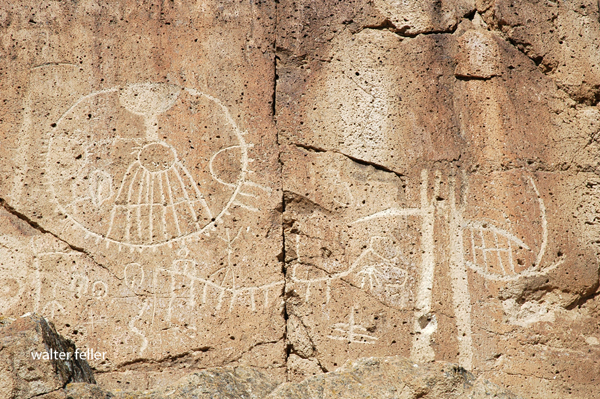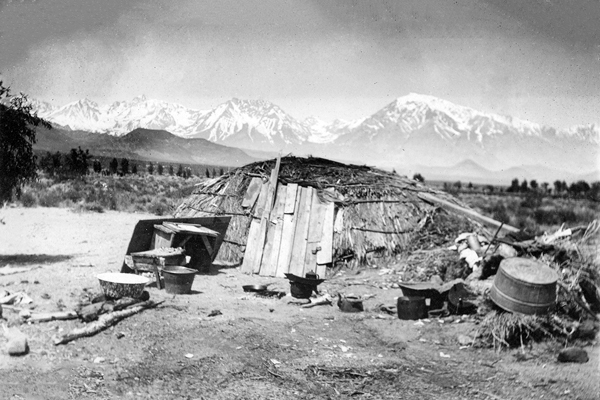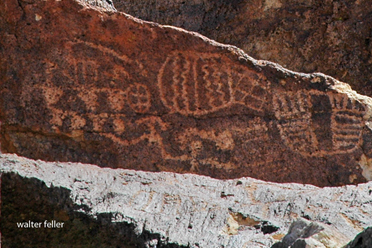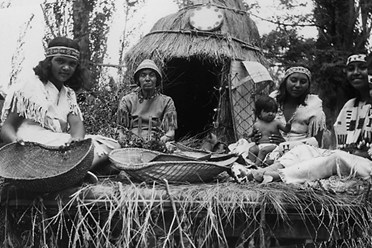Chapter II
Who were the First Families?
Before the white man, the Piute; before the Piute, what people, and for what duration of time?Geologist Bailey remarks that
"the remains of spear and arrow heads of obsidian, and the fossil bones of mastodon, horse and camel, mingled together, tell the story that elementary man lived along the shores of these ancient lakes."

Dr. A. L. Kroeber, of the University of California, takes direct issue with this, in writing: "The age of most of the animal remains is to be reckoned by tens of thousands of years. The age of the human finds, whether they consist of skeletons or implements, probably does not extend beyond hundreds or perhaps thousands of years. Such at least is the consensus of opinion regarding all properly authenticated human discoveries yet made on this continent. In Europe and Asia the history of man seems to go back nearly half a million years, but he seems to be a very late comer in America."
He says that in no case yet investigated has there been a certainty that the remains of animals and indications of the presence of human beings were actually associated, without chance of their having been shifted together by later human or natural intent or accident. The scientific tendency is to be
"exceedingly skeptical in advance regarding any such discoveiy. The opinion of Professor Bailey is matched by even more startling reports of Professor Whitney and Clarence King, but recent examination has led to a general disbelief in their reports."That a varied animal population roamed the wilds between these mountain ranges unguessable centuries ago is certain. Near Owens Lake, bones of some unidentified animal were brought up from 110 feet depth. Near Independence, men digging a well found, underneath a cedar log, bones of an animal of the horse species. Still nearer to us in point of time was a mastodon, the bones of which were uncovered at a depth of only twelve feet, also near Independence-an animal estimated by the San Francisco Academy of Sciences to have measured twenty-five feet in length and fourteen in height. Near Death Valley, in eastern Inyo, a few crumbling bits of bone and a few teeth were identified as the remains of a paleotherium, an animal of remote ages.
Not a dependable indication of man's presence in this valley in prehistoric times appears to have been found. The discovery, a few feet underground, of arrowheads of flint (not obsidian), and other articles not associated with the Piute tribe has been reported-probably indicating nothing more than the demise of a wandering warrior from some other region.

Paiute home - photo courtesy Owens Valley History
Discoveries made in well drilling prove that in olden times, and at different periods, Owens Valley was more or less wooded. The cedar log which apparently crushed the life from the ancient horse, already mentioned, probably toppled over untold years later than the growth of a black willow of which fragments were brought up from 281 feet depth near Big Pine; and many more centuries separated it from the life of a four-foot log, also apparently black willow, bored through 447 feet underground in the same artesian well. In this well fourteen distinct changes of natural conditions were indicated by as many strata of soils. In the clay beds there penetrated, mass after mass of tules was found.
A hazy Indian tradition reaches back to a time when groves and meadows abounded in these valleys, instead of the familiar sagebrush and, further eastward, desert and desolation. Fish and game were plentiful, say the story-tellers of the campfire circle. That happy period came to an end when the mountains burned and lakes dried up. While this tallies perfectly with scientific conclusions, it is unbelievable as a continuing tradition. It merely does credit to Indian powers of observation, deduction and imagination.
Those who believe that there once occurred a great aboriginal migration through Owens Valley cite the fact that a chain of petroglyphs, or rock markings, extends from the Columbia river southward, into and through Inyo County, and on into Arizona. Examination weakens this evidence, for pictured rocks are found all over the arid West. "The pictures are not the work of any one roam ing people," says one authority, "they have been made by all tribes, everywhere, at all times." While markings can be traced northerly and southerly, so can they be traced easterly, and in other directions. Those of one limited area are so unlike those found in another as to make it improbable that they were made by the same people. There are vague resemblances, but only such as would come from the possibility that different tribes, all lacking artistic conceptions, might chance to draw somewhat similar crude and simple designs.
Such rock markings are found in many places throughout the county, as well as to the north and the south. The largest group of petroglyphs in this part of the State is a few miles north of Bishop. It contains very little, if anything, that appears to be capable of interpretation. The Chief of the Bureau of Ethnology of the Smithsonian Institution writes, after examining photographs of the collection
"There is little likelihood that the petroglyphs can be interpreted by anyone. The petroglyphs of the Indians north of central Mexico were not drawn in accordance with a recognized system of symbols, but to a large extent were arbitrary and were controlled more or less by the personal fancy of the maker or makers."In the group mentioned are some delineations of deer, human and animal footprints, sinuous lines which may mean snakes, oval drawings with connecting lines possibly representing waters, upright lines with others branching as trees rarely do, and many-legged bugs. In general, however, the designs are but the crudest of geometrical figures, coils, gridirons, and apparently aimless chippings. It is said that petroglyphs found in the eastern part of the county show greater efforts at picturing than do those here described, including better drawn animal figures.
Present-day Piutes disclaim any knowledge of the meaning of the petroglyphs and of their origin, except as will be told in a later chapter on their legends. Dr. Kroeber, already quoted, considers this fact immaterial, remarking:
"I should be disposed to agree with your eonelusion that the pietographs are comparatively recent, and very likely made by the ancestors of the present Piutes, The ignorance of the present generation would prove very little. Since the traditions of most Indians are most fragmentaiy, knowledge of that kind would be almost certain to die out in three or four hundred years, and might be lost in a century."The markings are generally found in soft material such as tufa, and were made by chippings. A few are dim, but may have been only lightly cut. Others are fully a quarter-inch in depth. The bottoms of the carvings are lighter in color than the surface of the stone. This tends to prove their recentness, the cuts not having weathered for long periods. Carvings undoubtedly made by white men show precisely the same differences in coloring, and the investigator who takes the trouble to do some rock-marking on his own account will find that the surface he uncovers corresponds in shade with the bottoms of the unknown characters.
Corroborative evidence that the work was done at no far-removed period, and by the Piutes, is offered by bits of slate similarly marked, taken from opened Indian graves in which the bpnes are still fairly well preserved.
It is claimed that petroglyphs are found at camping places where there are or were springs or streams, and on natural routes of travel. There are exceptions to this, for some of the collections are in mountain nooks. The collections near Bishop are on the course of stream-beds or near ancient springs.
It may not unreasonably be concluded that the pictured rocks offer no evidence of tribal antiquity in the region, and that they have no value except as illustrating the some-time diversion of idle individuals of a primitive people.
WHO WERE THE FIRST FAMILIES? NO TRACES OF ANCIENT MAN-VARIED ANIMAL LIFE WHEN OWENS VALLEY WAS WOODED-ROCK MARKINGS THAT ARE APPARENTLY MEANINGLESS-THEIR ORIGIN UNKNOWN TO PRESENT RACE OF INDIANS-MAY BE COMPARATIVELY RECENT.


Paiute women